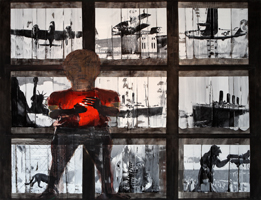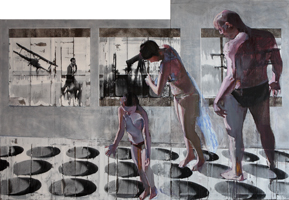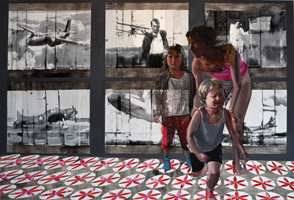WORK
2011./2013.
The Magnetic Burden of Time
Through a powerful suggestion, through the illusion of expanding the understanding of life in which we are immersed, art strives to ease our existence.
An artist has a "vision" – more-or-less clear, evocative images, conceptions to which he attaches importance. He sees them as exalted creations. They have – so he thinks – descended from the realm of subconscious.
Thus, artists form the ranks of the touched ones, inspired ones. Ennobled this way, armed with inspiration, most grow proud, and some humbly share their exalted treasure with others.
In either case, the assimilation, the processing and the expression – the emission – of inspiration create, grow, multiply and sustain the magnetic heap of time, as the poet Tin Ujević once said.
These fused thought-emotional forms, the information field of the collective unconscious, the astral, the invisible half of the world, exist, thus, at the expense of an artist's expression - and more generally, of the human expression, our expression, our "labour". The artist, oblivious, attributes the fruits of this labour to his own specific, personal qualities. We often hear: "This is my idea," or "That is his idea."
The Platonic concept of "Idea" referred to the reality of things, to states that are neither reflections nor shadows (to recall the Parable of the Cave.) The lack of a clear insight led to the concept of "Idea" being more commonly used to refer to a child of the magnetic heap of time, to a fruit of the so-called collective unconscious. That is not surprising, because the artistic and the human miss the reality, for humanity is immersed in the world that it has long been creating and that, in turn, shaped man and his world. This is the vicious circle, the cruel circle of existence doomed to itself.
We should accept that the artists' hearts (and, in principle, everyone's hearts) have been touched by reality, driving them to expression with unquenchable desire, but the reason and emotions, in accordance with their nature, project and twist the original impulse into a mental-emotional structure, an emblematic image, a "gift" of the magnetic heap of time.
Thus every artistic and human attempt to express the "Idea" in words, images... ends in a magnetic chaos. The end result is immanent to man and mankind as we know them, namely: art (science, philosophy) as it is.
The expression of the pure "Idea" in this context is called kitsch. Namely, art communicates through media, the "switchboard" of the collective unconscious, while kitsch attempts to cross the borders of media, to negate limits set by media, and thus produces an inauthentic result. We have an intuition of the perfect, of the timeless and of freedom within us, and we use art to help us bear the limitations of this temporal life, whereas kitsch points to eternity by forbidden means.
What happens when the magnetic heap of time becomes a heavy burden and grows to its current proportions, when its structure presses down heavily on everyone who breathes on Earth, when we sigh about this time of crises, tastelessness, kitsch?
The poet would cry: ''For I need the mighty word,
for I need the answer,
and love, or the holy death.''


